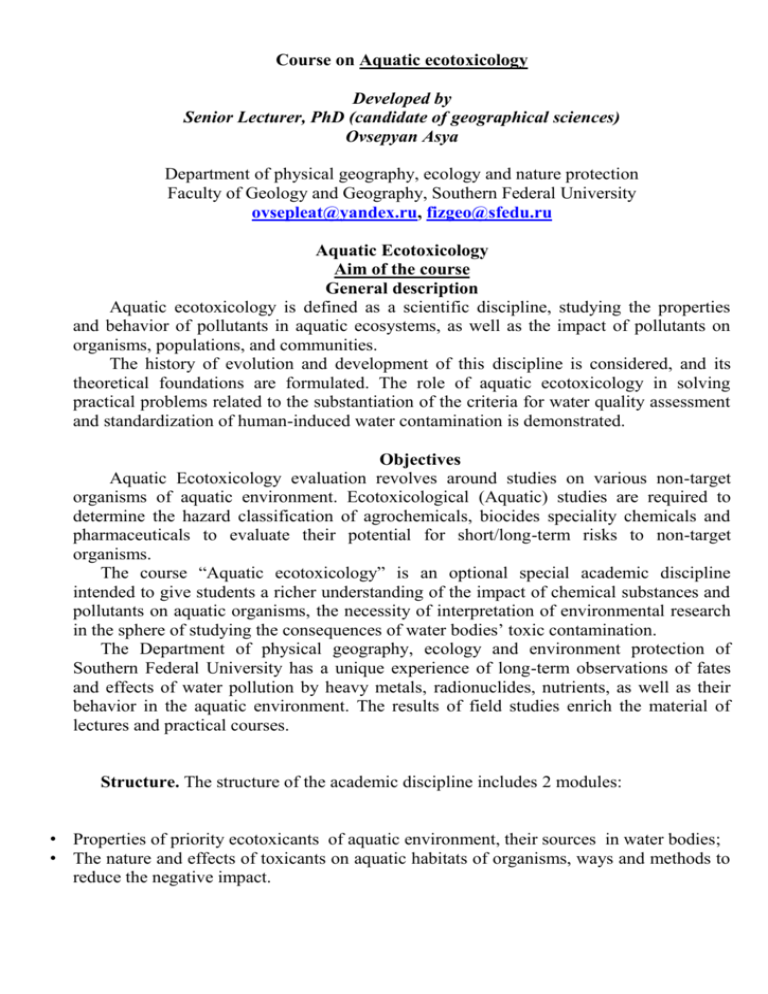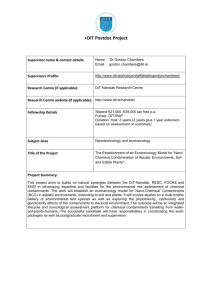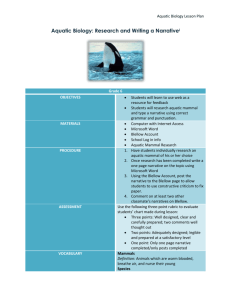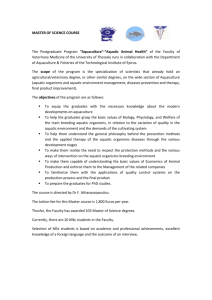Course description
advertisement

Course on Aquatic ecotoxicology Developed by Senior Lecturer, PhD (candidate of geographical sciences) Ovsepyan Asya Department of physical geography, ecology and nature protection Faculty of Geology and Geography, Southern Federal University ovsepleat@yandex.ru, fizgeo@sfedu.ru Aquatic Ecotoxicology Aim of the course General description Aquatic ecotoxicology is defined as a scientific discipline, studying the properties and behavior of pollutants in aquatic ecosystems, as well as the impact of pollutants on organisms, populations, and communities. The history of evolution and development of this discipline is considered, and its theoretical foundations are formulated. The role of aquatic ecotoxicology in solving practical problems related to the substantiation of the criteria for water quality assessment and standardization of human-induced water contamination is demonstrated. Objectives Aquatic Ecotoxicology evaluation revolves around studies on various non-target organisms of aquatic environment. Ecotoxicological (Aquatic) studies are required to determine the hazard classification of agrochemicals, biocides speciality chemicals and pharmaceuticals to evaluate their potential for short/long-term risks to non-target organisms. The course “Aquatic ecotoxicology” is an optional special academic discipline intended to give students a richer understanding of the impact of chemical substances and pollutants on aquatic organisms, the necessity of interpretation of environmental research in the sphere of studying the consequences of water bodies’ toxic contamination. The Department of physical geography, ecology and environment protection of Southern Federal University has a unique experience of long-term observations of fates and effects of water pollution by heavy metals, radionuclides, nutrients, as well as their behavior in the aquatic environment. The results of field studies enrich the material of lectures and practical courses. Structure. The structure of the academic discipline includes 2 modules: • Properties of priority ecotoxicants of aquatic environment, their sources in water bodies; • The nature and effects of toxicants on aquatic habitats of organisms, ways and methods to reduce the negative impact. Teaching The following methods and forms of study are used in the course: Lectures Seminars Colloquium Writing Self-study Use of different reference books and Internet resources At the end of the course the students are supposed to write an essay, make an oral presentation and participate in discussion. Upon the successful completion, the students will gain credits. Course content Training and thematic plan of the course on Aquatic ecotoxicology Total volume - 3 ECTS Credits Name of themes and topics Моdule 1: Properties of priority ecotoxicants of aquatic environment, their sources in water bodies Theme 1: Introduction. Course organization, its aims and structure. Information on core and additional readings. Theme 2: Formation of the science discipline. Subject of ecotoxicology and its links with other sciences Theme 3: Methodology and fundamental research principles Theme 4: Impacts of land contaminants on aquatic ecosystems Theme 5: Metal speciation in aquatic ecotoxicology Theme 6: Sediment toxicity identification evaluation Classroom (hour) The Selfamount study of hours Lectures Practice 54 16 11 27 7 2 1 4 8 2 2 4 8 2 2 4 11 4 2 5 11 4 2 5 9 2 2 5 Моdule 2: The nature and effects of toxicants 54 on aquatic habitats of organisms, ways and methods to reduce the negative impact Theme 7: Cell lines in aquatic toxicology 5 16 11 27 2 1 2 Theme 8: Aquatic biomarkers 8 2 2 4 Theme 9: Aquatic mesocosms in 8 ecotoxicology Theme 10: Aquatic macrophytes in 8 ecotoxicology Theme 11: Microbial bioremediation of 7 aquatic environments Theme 12: Bioavailability of contaminant 7 2 2 4 2 2 4 2 1 4 2 1 4 Theme 13: Water quality guidelines for the 5 protection of aquatic ecosystems Theme 14: Assessing ecological risks at 6 contaminated sites Totally 108 2 1 2 2 1 3 32 22 54 Monitoring system The final assessment of the course is determined by the results of monitoring on the basis of a rating system based on the outcome of the oral response classification, presented individually made reports on laboratory work, written essay, as well as active participation in lecture classes. Grading students on the rating system is determined in accordance with Table 1 Table 1 Excellent 90-100 points good 80-89 points satisfactory 65-79 points unsatisfactory less than 65 points Determination of credit is made according to table 2 Table 2 1. Active participation in lectures and seminars (quality recording Up to 20 of lectures and practical training material) 2. The results of case studies in laboratory studies. Up to 25 3. Essay Up to 35 4. Oral presentation Up to 20 Requirements During the session students are required to attend class lectures; participate in seminars; write an essay; represent the main ideas of essay in oral presentation at the colloquium; be prepared to participate in final course discussion. An essay is a prose analysis on one of the prescribed topics given below. For essay students should consult items from the booklist given with the essay title you choose. Students may use other items as well, but ensure that they are books or articles of relevance and equivalent scholarly standard to those on these lists. All recommended readings listed here are indicative rather than exhaustive. Students shouldn’t be afraid to add to the list from own literature searches. An essay will be assessed to the following criteria: range and quality of readings, evidence of investigative effort, relevance to essay question, awareness of relevant historians’ interpretations, use of primary evidence, analytical abilities and overall arguments. Recommended essay volume is approximately 2,5-3,000 words. Essay titles Select ONE topic 1. Environmental river biofilms as biological indicators of the impact of chemical contaminants 2. Ecotoxicity of explosives 3. Genotoxicity of contaminants: amphibian micronucleus assays 4. Genotoxicity of contaminants: Comet assay 5. Green chemistry and ecotoxicology 6. Landfill leachate ecotoxicity 7. Diatoms in ecotoxicology 8. Ecotoxicology: historical overview and perspectives 9. Optical sensors for detection of cyanobacteria 10.Oceans and human health 11.Trophic transfer of trace elements 12.Toxicity of urban stormwater 13.Photo-toxicity in ice 14.Microbiotests in ecotoxicology 15.Eutrophication 16.Biodegradability in ecotoxicology 17.Beluga whales and ecotoxicity 18.Benthic community ecotoxicology 19.Acid rain ecotoxicity 20.Migration and Retardation of Chemical Toxic Radioactive Waste Reading Abakumov, V.A., Ecological Modification and the Development of Biocenoses, in Ekologicheskie modifikatsii i kriterii ekologicheskogo normirovaniya (Ecological Modifications and Criteria of Ecological Standardization), Leningrad: Gidrometeoizdat, 1991, pp. 18 Alimov, A.F., Productivity of Macrozoobenthos Communities in Continental Water Bodies of the USSR, Gidrobiol. Zh. , 1982, vol. 18, no. 2, pp. 7–10. Alimov, A.F., Elementy teorii funktsionirovaniya vodnykh ekosistem (Principles of the Theory of Aquatic System Functioning), St. Petersburg: Nauka, 2000. Bigon, M., Kharper, Dzh., and Taunsend, K., Ekologiya. Osobi, populyatsii i soobshchestva (Ecology: Individuals, Populations, and Communities), Moscow: Mir, 1989. Braginskii, L.P., Some Classification Principles of Freshwater Ecosystem by Toxic Pollution Levels, Gidrobiol. Zh. , 1985, vol. 21, no. 5, pp. 57–67. Vinberg, G.G., Comparative–Biolimnological Studies, Their Potentialities and Limitations, in Produktsionnolimnologicheskie issledovaniya vnutrennikh vodoemov (Production–Limnological Studies of Inland Water Bodies), Leningrad: GosNIIORKh, 1986, p. 4–30. Grant, V., The Evolutionary Process , New York: Columbia Univ. Press, 1985. Kamshilov, M.M., Norm and Pathology in Aquatic Ecosystem Functionin, in Teoreticheskie problemy vodnoi toksikologii (Theoretical Problems of Aquatic Toxicology), Moscow: Nauka, 1983, p. 22–25. Lesnikov, L.A., System of Studies for the Development of Fishery-Related Water Quality Standards Taking Into Account the Peculiarities of Experimental Data Transfer to Natural Water Bodies, in Vliyanie zagryaznyayushchikh veshchestv na gidrobiontov i ekosistemy vodoemov (Effect of Pollutants on Aquatic Organisms and Ecosystems of Water Bodies), Leningrad: GosNIIORKh, 1979, pp. 301–309. Luk’yanenko, V.I., Ikhtiotoksikologiya (Ichthyotoxicology), Moscow: Agroprom, 1983. Metelev, V.V., Kanaev, A.I., and Dzasokhova, N.G., Vodnaya toksikologiya (Aquatic Toxicology), Moscow: Pishchevaya prom., 1971. Mikryakov, V.R., Reaktsiya immunnoi sistemy na zagryaznenie vody toksikantami i zakislenie sredy (Response of Immune System to Water Pollution by Toxicants and the Acidification of the Environment), Moscow: Nauka, 2001. Moiseenko, T.I., Anthropogenic Variability of Freshwater Ecosystems and Criteria for Water Quality Assessment, in Problemy ekologicheskogo monitoringa i modelirovaniya ekosistem (Problems of Ecological Monitoring and Ecosystem Modeling), St. Petersburg: Gidrometeoizdat, 2003, vol. 19, pp. 72–94. Moiseenko, T.I., Concept of Ecosystem “Health” in the Water Quality Assessment, Ekologiya , 2008, no. 5, pp. 4–18. Moiseenko, T.I., Ecotoxicological Approach to Water Quality Assessment, Vodn. Resur. , 2005, vol. 32, no. 4, pp. 163–174 [Water Resour. (Engl. Transl.), vol. 32, no. 2, pp. 163–174]. Moiseenko, T.I., Gashkina, N.A., Sharova, Yu.N., and Pokoeva, A.G., Ecotoxicological Assessment of After-Effects of the Volga River Water Contamination, Vodn. Resur. , 2005, vol. 32, no. 4, pp. 410–424 [Water Resour. (Engl. Transl.), vol. 32, no. 4, pp. 369–383]. Moiseenko, T.I., Lukin, A.A., Kudryavtseva, L.P., et al., Antropogennye modifikatsii ekosistemy ozera Imandra (Anthropogenic Modifications of Imandra Lake Ecosystem), Moscow: Nauka, 2002. Nemova, N.N. and Vysotskaya, R.U., Biokhimicheskaya indikatsiya sostoyaniya ryb (Biochemical Indication of Fish State), Moscow: Nauka, 2004. Nikol’skii, G.V., Teoriya dinamiki stada ryb (Theory of the Dynamics of Fish Shoals), Moscow: Pishchevaya prom-st', 1974. Odum, Yu.P., Fundamentals of Ecology , Philadelphia: W.B. Saunders, 1971. Stroganov, N.S., Biological Aspect of the Problem of Norm and Pathology in Aquatic Toxicology, in Teoreticheskie problemy vodnoi toksikologii (Theoretical Problems of Aquatic Toxicology), Moscow: Nauka, 1983, pp. 5–21. Stroganov, N.S., Problems of Aquatic Toxicology in the Context of Ecological Physiology, Gidrobiol. Zh. , 1967, vol. 3, no. 5, pp. 34–41. Sushchenya, L.M., Alimov, A.F., and Monakov, A.V., Urgent Problems of Aquatic Organism Ecology, Gidrobiol. Zh ., vol. 18, no. 6, pp. 63–72. Filenko, O.F., On the Life and Work of N.S. Stroganov, in Antropogennye vliyaniya na vodnye ekosistemy (Anthropogenic Impacts on Aquatic Ecosystems), Moscow: Mosk. Gos. Univ., 2005, pp. 5–8. Flerov, B.A., Ekologo-fiziologicheskie aspekty toksikologii presnovodnykh zhivotnykh (Ecological–Physiological Aspects of Freshwater Animal Physiology), Leningrad: Nauka, 1989. Shatunovskii, M.I., Ekologicheskie zakonomernosti obmena veshchestv morskikh ryb (Ecological Regularities in Marine Fish Metabolism), Moscow: Nauka, 1980. Shvarts, S.S., Ekologicheskie zakonomernosti evolyutsii (Ecological Regularities in Evolution), Moscow: Nauka, 1980. Yablokov, A.V. and Yusufov, A.G., Evolyutsionnoe uchenie (Evolutionism), Moscow: Vysshaya Shkola, 1981. Adams, S.M. and Ryon, M.G., A Comparison of Health Assessment Approaches for Evaluating the Effects of Contaminant-Related Stress on Fish Populations, J. of Aquatic Ecosystem Health , 1994, vol. 3, pp. 15–25. Attrill, M.J. and Depledge, M.H., Community and Population Indicators of Ecosystem Health: Targeting Links Between Levels of Biological Organization, Aquatic Toxicol, 1997, vol. 38, pp. 183–197. Biological Indicators of Stress in Fish. American Fishery Society Symposium–8, Adams, S.M., Ed., Maryland: Bethesda, 1990. Butler, G.C., Development in Ecotoxicology, Ecological Bull., 1984, vol. 36, pp. 9–2. Cairns, J.Jr., Restoration Ecology and Ecotoxicology. Handbook of Ecotoxicology , New York: Levis publishers Ltd, 2005, pp. 1015–1029. Cairns, J.Jr., The Predict, Validation, Monitoring and Migration of Anthropogenic Effect upon Natural Systems, Environ. Aud. , 1990, vol. 2, pp. 19– 25. Cash, K.J., Assessing and Monitoring Aquatic Ecosystem Health— Approaches Using Individual, Population, and Community, Ecosystem Measurements,1995, no. 45, p. 68. Chesser, R.K and Sugg, D.W, Toxicants as Selective Agents in Population and Community Dynamics, in Ecotoxicology: a Hierarchical Treatment, Newman, M.C. and Jagoe, Ch.H., Eds., N.Y.: Levis publishers Ltd, 1996, pp. 293–317. Erwin, T.A., An Evolutionary Basis for Conservation Strategies, Science , 1991, vol. 253, no. 6, pp. 750–752. Forbes, V.E. and Forbes, T.L., Ecotoxicology in Theory and Practice. Ecotoxicology Series, London, Glasgow, N. Y: Tokyo, Melbourne, Madras: Chapman&Hall Ltd, 1994. Hochachko, P.W. and Somero, G.N., Strategy of Biochemical Adaptation, Philadelphia: W.B. Saunder, 1973. Jagoe, C.H., Responses at the Tissue Level: Quantitative Methods in Histopathology Applied to Ecotoxicology. Ecotoxicology: a Hierarchical Trieatment, Newman, M.C., and Jagoe, C.H., Eds., New York: Levis publishers Ltd, 1996, pp. 163–196. Koehl, M.A.R, Discussion: From Individual to Population, in Perspectives in Ecological Theory, Roughgarden, J., May, R.M., and Levin, S.A., Eds., N.Y.: Princeton Univer. Press, 1989, pp. 39–53. Levin, S.A, Challenges in the Development of Theory and Ecosystem Structure and Function, in Perspectives in Ecological Theory, Roughgarden, R.M., May, R.M., and Levin, S.A., Eds., N.Y.: Princeton Univer. Press, 1989, pp. 242– 225. Moriarty, F., Ecotoxicology: The Study of Pollutants in Ecosystems, London; N. Y: Academic Press inc., 1989. Newman, M.C., Quantitative Methods in Aquatic Ecotoxicology, Boca Raton, Ann Arbor, London; Tokyo: Lewis Publishers Ltd, 1995. Newman, M.C. and Jagoe, C.H., Ecotoxicology: a Hierarchical Treatment, New York: Levis publishers Ltd, 1996. Rand, G.M. and Petrocelli, S.R., Fundamentals of Aquatic Toxicology, Hemisphere, 1985, vol. 113, no. 6, pp. 112–125. Rapport, D.J., Regier, H.A., and Hutchinson, T.C., Ecosystem Behaviors Under Stress, Am. Nat., 1985, vol. 125, pp. 617–640. Rozman, K.K. and Doull, J., General Principles of Toxicology, Environ. Toxicology: Current Development, 1998, pp. 3–8. Stearns, S.C., The Evolution of Life History, Oxford: Oxford Univ. Press, 1992. Thruhaut, R., Ecotoxicology: Objectives, Principles, and Perspectives, Ecotoxicol. Environ. Saf., 1977, pp. 151−173. Walker, C.H., Hopkin, S.P., Sibly, R.M., and Peakall, D.B., Principles of Ecotoxicology, London: Taylor&Francis Ltd, 2001. Whitfield, A.K., and Elliott M., Fish as Indicator of Environmental and Ecological Changes within Estuaries: a Review of Progress and Suggestions for the Future, J. Fish Biol., 2002, vol. 61, no. 4. pp. 229–250





